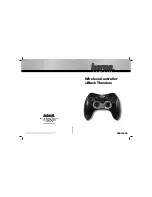
14
80-1403-01, Rev. 3
ANALOG CONTROL OVERVIEW
Actuators equipped with a HART / Local style
DCM-3 (P/N 20-5014-59) use a standard 4–20 mA
analog input signal for positioning. This design is
capable of providing very accurate control. Access
to configuration parameters and status parameters
requires a HART interface or a serial interface.
Simple Position and Demand setup, as well as
simple diagnostics can also be accessed using the
pushbutton / LED interface on the DCM-3 board.
For information on the Demand adjustment, refer
to page 33; for information on the output shaft
position, refer to page 31.
When installing the actuator, give attention to
the direction the output shaft moves in response
to an increasing Demand signal. For more
information on travel direction, refer to page 29.
HART COMMUNICATION
OVERVIEW
The HART communication interface is a
method of superimposing digital data onto what
appears to be a conventional 4 mA to 20 mA control
signal. Details and specifications of the interface
are maintained by the HART Communication
Foundation (HCF).
In a typical HART application, the HART
signals share the two wires typically used for
Demand in analog systems. HART specifically
targets analog systems based on the 4 mA to
20 mA, 250 ohm signaling convention. If the
resistance in the loop is significantly higher or
lower than 250 ohms, digital communication may
fail. HART communication frequencies are 1200
Hz and 2200 Hz. Instruments powered from the
mA signal may not have a measurable resistance
of 250 ohm, but must have signal filtering so
the resistance appears to be 250 ohm at the
communication frequencies. Resistance of 250
ohm must describe the master-slave connection,
but the effective resistor can be in the master or in
the slave. Consistent with the connection scheme
for actuators, Beck uses a passive 250 ohm
resistor on the DCM-3.
The HART communication system is based on
a master-slave data exchange. The master controls
writing and reading data. In the HART system,
the control system or hand held communicator is
the master, and the field device, such as the Beck
actuator, is the slave.
HCF specifies the format of the data and
some of the data content, but most of the data
communicated is at the discretion of the field
device manufacturer, such as Beck. The DCM-3
HART interface has access to a large set of
data. To access this data, the technician’s HART
communication device must be aware of what data
is available. This data awareness is controlled by
what is called a Device Description (DD). The
Beck DD for the DCM-3 is registered with HCF and
is available from HCF. The proper DD is described
by the manufacturer number (Beck is 0x68) and
the DD number (0xEF).
For compatibility with older DCM installations,
the DCM-3 is able to be set to communicate with
HART devices using an older DD. However, the
older DD does not give access to all the DCM-3
functionality, and this DD should only be used if
the newer DD is not available. This older DD is
denoted by the same Beck manufacturer number
(0x68) and a different DD number (0x01).
As defined by the HART protocol, a slave
device can identify only one compatible DD type.
Therefore, to have the DCM-3 identify an older DD
INSTALLATION
Electrical
Содержание 14-100
Страница 85: ...85 80 1403 01 Rev 3 17 18 2 1 6 5 8 6 3 4 9 14 15 25 7 16 CONTROL ASSEMBLY AND DRIVE TRAIN...
Страница 87: ...87 80 1403 01 Rev 3 14 15 17 18 2 1 6 5 8 6 3 4 9 14 15 25 7 16 CONTROL ASSEMBLY AND DRIVE TRAIN...
Страница 90: ...90 80 1403 01 Rev 3 NOTES...
Страница 91: ...91 80 1403 01 Rev 3...















































